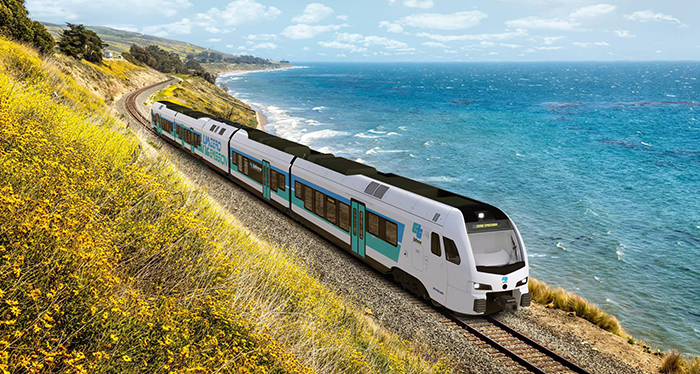Mileposts

Mile Marker graphic
Seven new rail cars feature ADA-accessible features
Train passengers traveling in Northern California and the Central Valley will be able to enjoy a more comfortable and modern ride with the launch of seven new Venture Passenger Rail Car trains unveiled during a Caltrans and San Joaquin Regional Rail Commission event at the Stockton Regional Maintenance Facility.
The single-story, fully ADA-accessible passenger cars provide wider aisles, accessible restrooms and fully-automated doors, continuing California’s expansion of comfortable and convenient options for travelers and commuters.
The trains will be used on the Amtrak San Joaquin line, which runs five daily roundtrips between Oakland and Bakersfield, and two daily roundtrips between Sacramento and Bakersfield. The first six-car set is in operation on the Oakland-Bakersfield route and helps restore service to pre-pandemic levels and sets the course for future service improvements.
These new rail cars are the first upgrade to the passenger riding experience on the Amtrak San Joaquin’s line in nearly three decades. They allow wheelchair users to move easily between cars.
Siemens Mobility, under contract to Sumitomo Corporation of Americas, built the rail cars at their facility in Sacramento, with finish work performed at the Stockton Regional Maintenance Facility, owned by the San Joaquin Regional Rail Commission. Caltrans purchased the new rail cars with $132 million in federal and state funds.

Equity tool looks to ensure transportation system helps all
On March 4, Caltrans launched an equity tool designed to help all Californians benefit from transportation projects and identify communities most negatively impacted by the transportation system, those that experience excessive rates of traffic, crashes, and air pollution, as well as limited transit options.
The Caltrans Transportation Equity Index (EQI) tool will help inform project selection, program evaluation, and policy decisions, better align the transportation system to state environmental and equity goals and help address transportation-related inequities.
Data will be used to identify transportation-based priority populations to help alleviate traffic-related impacts. Caltrans aims to advance equitable outcomes during project planning, development, and design phases, for both the department and partner public agencies.
Caltrans began developing the EQI in 2021 as a commitment to the department’s equity statement and to deliver on the Climate Action Plan for Transportation Infrastructure (CAPTI).

Headquarters graphic
Six more zero-emission, hydrogen-powered trainsets ordered
On Feb. 14, Caltrans announced a $127 million agreement with Stadler Rail, Inc. for six more zero-emission, hydrogen-powered passenger trainsets, building upon an earlier order to deliver the first four hydrogen-powered intercity trainsets in North America, furthering California’s standing as a world leader in clean transportation.
The trains will help California adapt to climate change by strengthening the state’s zero-emission passenger rail capabilities. The first trains are expected to enter revenue service in 2027. The trainset design will make them more efficient, lighter weight and more affordable than traditional locomotive-hauled coaches.
The purchase is funded through Governor Gavin Newsom’s historic multiyear zero-emission vehicle package, which included $407 million for the California State Transportation Agency (CalSTA) to purchase or lease state-of-the-art clean bus and rail equipment and infrastructure.
The first trains will operate between Merced and Sacramento on the future Valley Rail service ― an expansion of the existing Altamont Corridor Express (ACE) and Amtrak San Joaquins services that will eventually connect with the first section of California’s high-speed rail service. The trains will also be demonstrated on corridors throughout the state in coordination with intercity and regional rail partners. Nineteen trainsets remain on the base contract that Caltrans signed with Stadler in October 2023.

